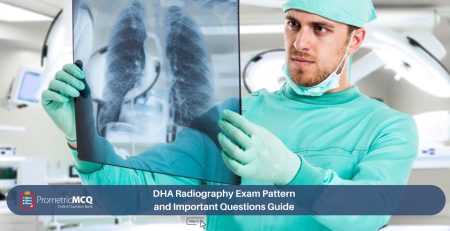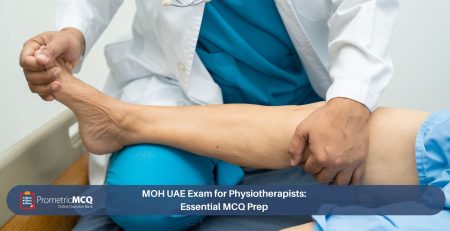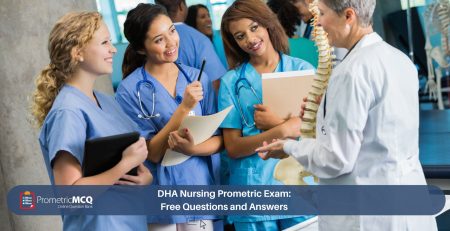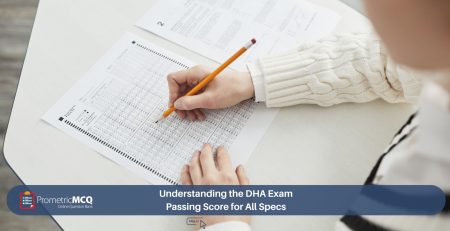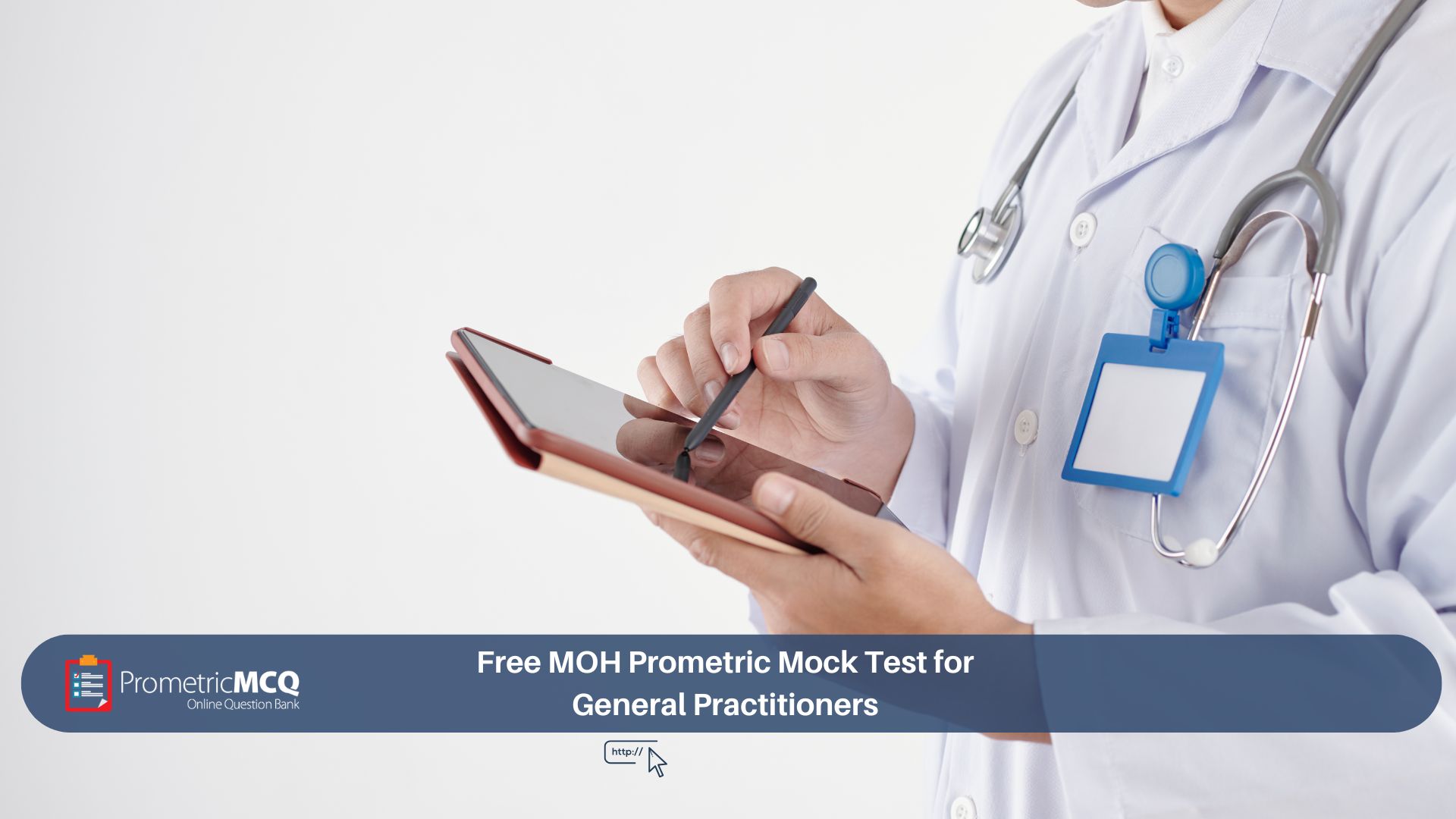
Free MOH Prometric Mock Test for General Practitioners
fatima@prometricmcq.com2025-09-15T12:56:13+00:00Table of Contents
ToggleFree MOH Prometric Mock Test for General Practitioners (2025)
For General Practitioners (GPs) seeking to practice in the UAE’s Northern Emirates, the Ministry of Health and Prevention (MOHAP) exam is the definitive gateway. This comprehensive assessment rigorously evaluates your clinical knowledge, diagnostic acumen, and ability to manage a wide spectrum of patient cases. While theoretical study is foundational, nothing prepares you for the unique pressures and question styles of the MOH exam like a high-quality mock test. It is the single most effective tool for transforming your knowledge into a passing score.
A well-designed mock test does more than just quiz you; it simulates the real exam environment, forcing you to apply your knowledge under timed conditions. It is a diagnostic tool that ruthlessly exposes your weaknesses, allowing you to focus your remaining study time with laser precision. The entire process, from application to exam day, can be complex, and our MOH Examination Guide provides a complete overview.
This guide offers a comprehensive, free MOH Prometric mock test specifically crafted for General Practitioners. Below, you will find a series of high-yield, case-based MCQs that mirror the format and difficulty of the actual 2025 exam. Each question is followed by an exhaustive rationale that not only explains the correct answer but also deconstructs the incorrect options, providing a deep learning experience. Use this resource to benchmark your current knowledge, refine your test-taking strategy, and build the confidence needed to succeed.
Why This Mock Test is Essential for Your Success
- Realistic Exam Simulation: The questions are case-based vignettes, mirroring the clinical reasoning tested on the actual MOH GP exam.
- High-Yield Topic Coverage: The questions are strategically chosen from the most frequently tested areas in internal medicine, pediatrics, OB/GYN, and emergency medicine.
- In-Depth Rationales: Learn from every question with detailed explanations that solidify your understanding of core concepts.
- Identify Your Weaknesses: Use your results to pinpoint specific topics that require more focused study.
- Build Confidence and Stamina: Practicing under timed conditions reduces exam-day anxiety and improves your pacing.
Your Free MOH GP Mock Test
Instructions: Try to answer all questions. There is no negative marking. For the best simulation, give yourself approximately 25-30 minutes to complete this section. Analyze the detailed rationales after you have completed the entire test.
Question 1: Internal Medicine (Cardiology)
A 65-year-old male with a known history of hypertension and type 2 diabetes presents to the emergency department with a 2-hour history of severe, crushing central chest pain radiating to his left arm. An ECG shows ST-segment elevation in leads II, III, and aVF. Which coronary artery is most likely occluded?
- Left Anterior Descending (LAD) artery
- Left Circumflex (LCx) artery
- Right Coronary Artery (RCA)
- Posterior Descending Artery (PDA)
Correct Answer: C
Rationale: The ECG findings of ST-segment elevation in leads II, III, and aVF are the hallmark of an acute inferior wall myocardial infarction (MI). The inferior wall of the left ventricle is primarily supplied by the Right Coronary Artery (RCA) in about 85% of the population (right-dominant circulation). Therefore, an occlusion of the RCA is the most probable cause of these ECG changes.
Why other options are incorrect:
A: Occlusion of the LAD artery typically causes an anterior wall MI, which would present with ST elevation in the precordial leads (V1-V4).
B: Occlusion of the LCx artery usually causes a lateral wall MI, with ST elevation in leads I, aVL, V5, and V6.
D: The PDA is typically a branch of the RCA. While a PDA occlusion causes the MI, the main vessel that is occluded is the RCA proximally.
Question 2: Pediatrics
A 2-year-old child is brought to the clinic with a 3-day history of high fever, cough, coryza, and conjunctivitis. Today, the mother noticed small white spots on the child’s buccal mucosa. A maculopapular rash has just started to appear on the face and behind the ears. What is the most likely diagnosis?
- Rubella (German Measles)
- Roseola Infantum
- Rubeola (Measles)
- Varicella (Chickenpox)
Correct Answer: C
Rationale: This is a classic presentation of Rubeola (Measles). The prodrome of the three “C’s” (cough, coryza, conjunctivitis) and fever, followed by the appearance of Koplik’s spots (the small white spots on the buccal mucosa), is pathognomonic for measles. The cephalocaudal (head-to-toe) spread of the maculopapular rash further confirms the diagnosis.
Why other options are incorrect:
A: Rubella has a similar rash but a milder prodrome and is associated with posterior auricular lymphadenopathy, not Koplik’s spots.
B: Roseola is characterized by several days of high fever that abruptly ceases as a rash appears on the trunk.
D: Varicella presents with a vesicular rash (“dewdrop on a rose petal”) that appears in successive crops all over the body, not a maculopapular rash starting on the face.
Question 3: Obstetrics & Gynecology
A 28-year-old woman at 32 weeks gestation presents with sudden-onset, painless, bright red vaginal bleeding. Her abdomen is soft and non-tender on palpation, and the fetal heart rate is reassuring. What is the most likely diagnosis?
- Placental Abruption
- Placenta Previa
- Vasa Previa
- Cervical Ectropion
Correct Answer: B
Rationale: The classic triad for placenta previa is painless, bright red vaginal bleeding in the third trimester. The absence of abdominal pain or uterine tenderness is a key feature that distinguishes it from placental abruption. In placenta previa, the placenta is implanted in the lower uterine segment, partially or completely covering the cervical os.
Why other options are incorrect:
A: Placental abruption (premature separation of the placenta) typically presents with painful vaginal bleeding, a firm and tender uterus (hypertonic), and signs of fetal distress.
C: Vasa previa is a rare but catastrophic condition where fetal vessels run over the cervical os. It typically presents with bleeding upon rupture of membranes, followed immediately by severe fetal distress (bradycardia).
D: Cervical ectropion can cause light bleeding or spotting but is an unlikely cause of significant, sudden-onset bleeding in the third trimester.
Question 4: Emergency Medicine
A 22-year-old female is brought to the emergency department after being found confused and drowsy. Her respiratory rate is 8 breaths/minute and shallow. Her pupils are pinpoint. Needle tracks are noted on her arms. What is the most appropriate immediate intervention?
- Administer activated charcoal
- Administer flumazenil
- Administer naloxone
- Prepare for endotracheal intubation
Correct Answer: C
Rationale: This clinical picture—respiratory depression (bradypnea), altered mental status, and miosis (pinpoint pupils)—is the classic triad of opioid toxicity. Given the history of needle tracks, an opioid overdose is highly likely. Naloxone is a competitive opioid antagonist and is the specific antidote that will rapidly reverse the effects of the opioid, especially the life-threatening respiratory depression.
Why other options are incorrect:
A: Activated charcoal is used for GI decontamination in some oral overdoses but is not the priority in a patient with a compromised airway and is ineffective for IV drugs.
B: Flumazenil is the antidote for benzodiazepine overdose, which typically presents with sedation but not the severe respiratory depression and pinpoint pupils seen here.
D: While intubation may become necessary if the patient does not respond to naloxone or has other complications, administering the antidote first is the most appropriate and potentially definitive immediate step.
Question 5: Internal Medicine (Endocrinology)
A 50-year-old female complains of fatigue, weight gain, and constipation over the past six months. On examination, her face appears puffy, her skin is dry, and she has delayed relaxation of her deep tendon reflexes. Her heart rate is 55 bpm. Which of the following lab tests would be most specific to confirm the diagnosis?
- Total T4
- Free T4
- Thyroid Stimulating Hormone (TSH)
- Thyroglobulin Antibodies
Correct Answer: C
Rationale: The patient’s symptoms and signs are classic for hypothyroidism. In primary hypothyroidism (the most common cause, due to thyroid gland failure), the thyroid gland is unable to produce enough T3 and T4. The pituitary gland senses this and increases the production of TSH in an attempt to stimulate the failing gland. Therefore, a high TSH level is the most sensitive and specific initial test to diagnose primary hypothyroidism. A low Free T4 would be expected and would confirm the diagnosis.
Why other options are incorrect:
A & B: While Total T4 and Free T4 would be low, they are not the initial screening test. TSH is more sensitive because it rises exponentially in response to small drops in thyroid hormone production.
D: Thyroglobulin antibodies (along with TPO antibodies) are used to determine the etiology (e.g., Hashimoto’s thyroiditis), but not to make the initial diagnosis of hypothyroidism itself.
How to Analyze Your Mock Test Performance
Completing the test is only half the battle. The real learning happens now.
- Review Every Question: Don’t just look at the ones you got wrong. Review the ones you got right to ensure your reasoning was correct and it wasn’t just a lucky guess.
- Analyze the Rationales Deeply: Understand not only why the correct answer is right, but why every other option is wrong. This is how you build true clinical judgment.
- Categorize Your Errors: Did you make a knowledge-gap error (you didn’t know the information), a misreading error (you misunderstood the question stem), or a test-taking error (you fell for a distractor)? Identifying the type of error helps you correct it.
- Create a “Weakness List”: Based on your errors, create a list of specific topics you need to revisit. If you missed the MI question, your topic is “ECG Localization of MI.” If you missed the measles question, your topic is “Pediatric Exanthems.”
Frequently Asked Questions (FAQs) for the MOH GP Exam
This mock test is designed to be highly realistic in its question style, focusing on case-based scenarios that require clinical reasoning. The topics are high-yield and reflect the breadth of a general practitioner’s knowledge. The actual exam will be longer, but the difficulty and format of individual questions are well-represented here.
While the unofficial passing score for the MOH GP exam is estimated to be around 65%, you should aim for a consistent score of 70-75% or higher on practice tests. This creates a safe buffer to account for exam-day anxiety and encountering unexpected questions.
In the initial phase of content review, focus on learning. In the last 3-4 weeks of your preparation, you should take one or two full-length mock exams per week. This helps you build stamina, perfect your time management, and track your progress.
The best way is to keep an error log. For every question you get wrong, write down the topic, a brief summary of why you chose the wrong answer, and a summary of the correct rationale. Reviewing this log regularly is a highly effective way to learn from your mistakes.
Yes, absolutely. The Prometric exam format fully supports images. You can expect to see questions that require you to interpret ECGs, chest X-rays, CT scans of the head, or clinical images of dermatological conditions. It’s a crucial part of testing a GP’s diagnostic skills.
The MOH exam is based on international, evidence-based guidelines. A fantastic and highly respected resource for this is the UK’s National Institute for Health and Care Excellence (NICE). Their clinical guidelines are free to access and provide clear, evidence-based recommendations on a vast range of topics. You can explore them at the official NICE guidance website.
The GP exam is incredibly broad, covering the “bread and butter” of internal medicine, pediatrics, OB/GYN, and primary care emergencies. A specialty exam (e.g., MOH Cardiology) is much deeper and narrower, focusing on advanced topics, complex procedures, and detailed guideline knowledge within that specific field.
Once you pass the MOH exam, you receive an eligibility letter which is typically valid for one year. Within this period, you must complete the DataFlow (PSV) process and secure a job offer to activate your UAE MOH license.
Do not panic! A poor score on an early mock test is a valuable diagnostic tool, not a final judgment. It has successfully done its job: showing you where your knowledge gaps are. Use the results to create a targeted study plan. Go back to the basics for your weak subjects and then re-test yourself later.
While free tests are a great starting point, a comprehensive preparation strategy requires a larger pool of questions. Investing in a dedicated, high-quality question bank is the most effective way to ensure you cover all the necessary topics. You can find specialized and extensive question banks at PrometricMCQ for MOH GP.
Conclusion: From Practice to Passing
The MOH General Practitioner exam is a challenging but surmountable obstacle on your path to practicing in the UAE. The key to unlocking your potential lies in active, strategic preparation. This free mock test serves as your initial diagnostic tool, but the real progress comes from a sustained commitment to practicing with high-quality MCQs, analyzing your mistakes, and reinforcing your clinical knowledge. Embrace this process, and you will not only be prepared to pass the exam but will also be a more competent and confident physician.
Ready to Ace Your MOH GP Exam?
Our premium MOH General Practitioner QBank offers hundreds of high-yield, case-based questions, detailed rationales, and simulated exams to give you the ultimate advantage on exam day.



